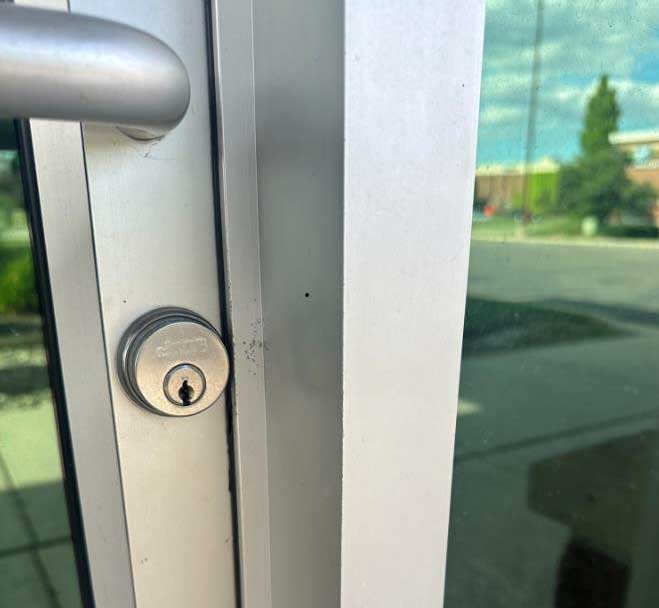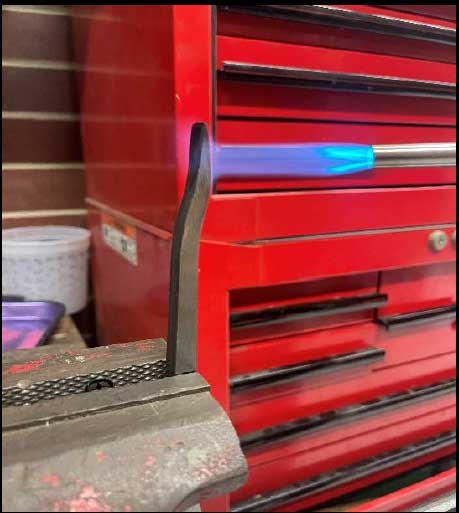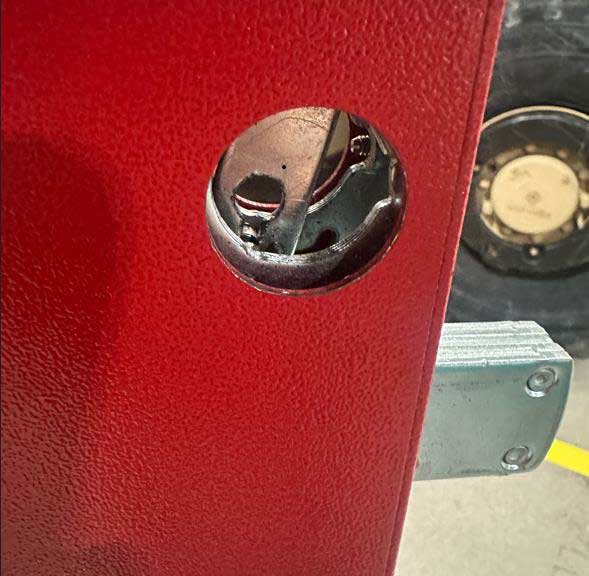Photos by author
As firefighters, our sole responsibility is to provide a service to our community unlike any other. Firefighters arrive at incidents to make things better, to improve a situation, and to mitigate problems for people. We are a sought-after profession with worldwide respect and approval. Over the last few years, numerous studies on public opinion have shown that firefighters rank in the top three most respected professions and routinely rank as the number one respected profession. In 2022, a Forbes Magazine poll showed that firefighters were thought to be the most respected professionals by 82% of people (Brower, 2024).
- Don’t Break the Glass: Storefront Through-the-Lock Training
- Training Minutes: Through-the-Lock Entry: Tubular Deadbolt
- Throw Back to Basics: Commercial Lock Forcible Entry
- Through-the-Lock Entry for Storefront Doors
Forbes used metrics to measure why people thought a profession was respected centered on trustworthiness, helping others, and essentialness to society. When firefighters arrive on scene, we ought to be aware of these things and that this is what citizens expect. Arriving at incidents and unnecessarily destroying property in the name of “operations” detracts from this standard. It is crucial to employ techniques to mitigate incidents that do not add unneeded destruction to an already potentially destructive incident.
Understanding the Needs at Hand
We have all experienced the calls for service that require us to gain access to a space, whether through Knox Box keys, a building maintenance worker, a neighbor, or traditional forcible entry. Not every incident we are called to requires traditional forcible entry methods. Although effective, a set of irons is not always the most appropriate method for gaining access to a space.
As a firefighter who is actively aware of their craft, we have likely heard the term “through the lock” in regards to forcible entry. I was introduced to K tools in the academy when learning forcible entry techniques for removing doorknobs and deadbolts. This works great for standard single-family residential occupancies with our normal, run-of-the-mill entry doors. But what about those of us who serve a more metropolitan community, and are responding to commercial occupancies with large, unique glass storefronts and doors? Firefighters cannot consistently use a K tool for access to those spaces.

We are often presented with expensive glass doors with exposed lock cylinders when responding to commercial fire alarms in strip malls, doctors’ offices, shopping malls, or grocery stores. The lock cylinder does its job of locking the mortise lock of these aluminum-framed glass doors but leaves itself exposed on the face of the door frame (photo 1). When presented with this style of locking mechanism, through-the-lock forcible entry is the most appropriate for low-level calls such as odor investigations or fire alarms. This style of forcible entry shines through when we show up and uphold the standard of providing exceptional customer service and don’t add destruction to an incident.
Through-the-lock pliers make use of the exposed cylinder being accessible to us. As one can imagine, a large, full-glass door on a metal frame is a costly investment by the occupancy owner. In contrast to that expense, the locking cylinder is a readily available part that can be replaced by any locksmith at a minimal cost to the occupancy owner. Rather than simply throwing our halligan bar through the door glass, it’s preferable to gain access to the space we are there to investigate by going through the locking. Obviously, destructive forcible entry will also gain us access to the space, but is that style of forcing entry the most appropriate choice for a fire alarm, odor investigation, or good intent call?
Understanding Through-the-Lock Pliers
Through-the-lock pliers are not a new tool to the fire service. Thousands of firefighters across the country carry these pliers in their bunker gear every day. Through-the-lock pliers are created by making simple modifications to a pair of slip-joint pliers. Several variations of these pliers are available commercially to be modified by the user. Slip-joint pliers that have already been modified into through-the-lock pliers can also be commercially purchased. Modifying a pair of slip-joint pliers into through-the-lock pliers does not require significant mechanical aptitude and can be completed in less than an hour in the firehouse workshop.
A few tools and pieces of equipment will be needed to make the modifications to your slip-joint pliers. There are multiple ways to modify your slip-joint pliers for through-the-lock applications, but the below method is the most simplistic and efficient that I have found. Additionally, this is the exact method used to make the pair I personally carry in my bunker gear.

Let’s look at the steps to modifying your pliers:
- Use a utility knife to remove the vinyl or rubber coating on the pliers.
- Once removed, secure the “lower” handle in a bench vice and begin to heat with a handheld propane torch (photo 2)
- Once the metal is a nice, glowing orange, carefully remove the handle from the vice, turn it over, and bend the bottom 0.50–0.75 inches of the handle you just heated to a 90° angle in the bench vice. Bending it either inward or outward is acceptable. Bending it outward makes it easier to manipulate the lock internals whereas bending it inward makes it easier to stow in your pockets.
- Once the metal has cooled, use a bench grinder or disc grinder to flatten each end of the handle to the size of a regular slotted screwdriver, approximately 0.375 inches wide.
- An optional change: Wrap the handles with hockey or baseball bat tape to provide a better gripping surface that is more user friendly.
Once you have completed the modifications as listed above, you now have a functional pair of through-the-lock pliers that can be used at the next commercial fire alarm you respond to.
These pliers function exactly like a normal pair of slip-joint pliers, but by modifying the handles slightly, we now have a set of homemade “keys” for manipulating the internals of a mortise lock. These “keys” on the end of our plier handles are akin to the keys that we see in K-tool pouches. Upon completion of the modifications, your pliers should look something like the pliers shown in photo 3.

Using Your Pliers on Scene
Use the pliers on scene when endeavoring to conserve property and minimize damage. When we arrive at mundane or routine calls such as fire alarms or odor investigations, we do not have the same sense of urgency as we have when we arrive at a rolling structure fire. We would not use through-the-lock pliers when we’re on the scene of a structure fire, but they are incredibly useful on the scene of a commercial fire alarm or odor investigation.
As we saw back in photo 1, commercial doors with exposed cylinders are where through-the-lock pliers shine through for use. These cylinders are usually held in place with a small setscrew and threaded in place, or press-fit into the door face and hold the actual lock and key tumbler for the door mortise lock. Use the jaws of the through-the-lock pliers as you would a traditional plier to defeat the setscrew, unscrew the threaded cylinder, or physically remove the press-fit lock cylinder and remove it. Remove the cylinder from the face of the door to expose the mortise lock internals. With the lock internals exposed, use the bent end of the pliers or the flat-head end to manipulate the lock to the unlocked position.

When manipulating the internals of the mortice lock, remember that the deadbolt locking bar will only actuate between the 5 and 7 o’clock position relative to the cylinder circle (12 o’clock being the top of the cylinder circle). When a key is inserted in normal circumstances, the key will rotate 360°, but the deadbolt locking bar will only lock or unlock between the 5 and 7 o’clock position. When we expose the internals of the mortise lock, use the through-the-lock pliers as keys to manipulate the internals just as a key does. Photo 4 shows the internals of a common mortise-style lock. This is where you will find the pieces of linkage to manipulate the deadbolt bar and allow you to unlock the door. The steps to effectively use your through-the-lock pliers on scene are as follows:
- Place the jaws of the locking pliers around the exposed cylinder and quickly twist the cylinder counterclockwise and then quickly back clockwise. This will shear off any setscrews holding the cylinder in place.
- Begin unscrewing the cylinder from the face of the doorframe now that it has been broken loose from the doorframe face.
- With the cylinder removed from the doorframe, we can now use the bent end or the flat end of our through the lock pliers to manipulate the locking mechanism inside the doorframe.
- Using the flat or bent end of the handle, begin to move the latch in the bottom of the cylinder hole to the 5 or 7 o’clock position to unlock the deadbolt bar.
Bringing it All Together
Although an incredibly useful tool for certain circumstances in the fire service, through-the-lock pliers are no replacement for traditional forcible entry tools. When structures are burning, time is of the essence to make entry. It is not recommended to use through-the-lock pliers to gain access in these situations. However, these pliers work exceptionally well when we are called to incidents of a mundane nature, where we have time to operate. When we recognize our response area occupancies, we can better serve our citizens by not destroying their property when called to a simple fire alarm. Next time you are operating in your first-due area, take a look at its storefronts. Notice how common these style doors are and take some time to prepare to effectively use your new through-the-lock pliers the next time you show up.
Chief Alan Brunacini spent the majority of his career telling us to provide the best customer service we could as public servants. Not destroying property for calls that do not require destructive force is a great way to uphold that message. Solving a problem for our citizens while also maintaining property integrity is one way to keep firefighters regarded as one of the most respected professions in the world.
Reference
Tracy Brower, PhD. “New Data: The Most Respected Jobs and 5 Ways to Gain Respect No Matter What Your Work.” Forbes, Forbes Magazine, 20 Feb. 2024, www.forbes.com/sites/tracybrower/2022/05/30/new-data-the-most-respected-jobs-and-5-ways-to-gain-respect-no-matter-what-your-work/.
Quintin Pavel is a six-year veteran of the fire service and currently serves as a firefighter in the suburban metro Detroit area. He holds a Michigan residential builders license and has a degree in mechanical engineering from Central Michigan University.

